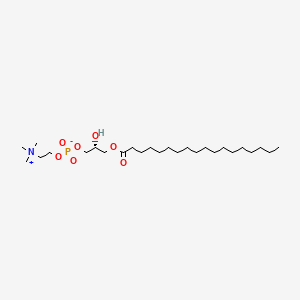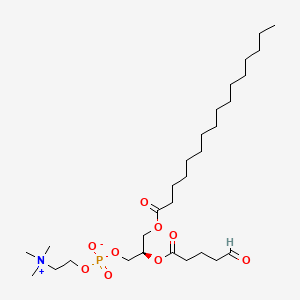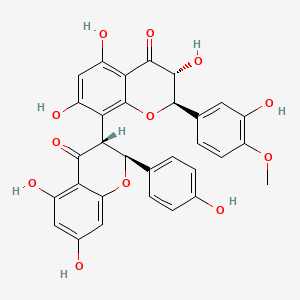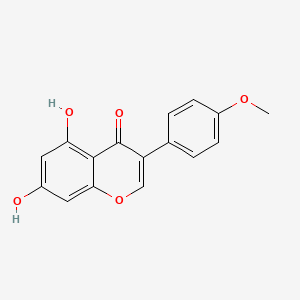
|
1-octadecanoyl-sn-glycero-3-phosphocholine |
1-octadecanoyl-sn-glycero-3-phosphocholine is a lipid of Glycerophospholipids (GP) class. 1-octadecanoyl-sn-glycero-3-phosphocholine is associated with abnormalities such as Septicemia. The involved functions are known as Phosphorylation, MAP kinase activity, Phagocytosis, protein serine/threonine kinase activity and Uptake. The associated genes with 1-octadecanoyl-sn-glycero-3-phosphocholine are FPR1 gene and OLR1 gene. The related lipids are Lysophosphatidylcholines. |
42 |

|
POV-PC |
POV-PC is a lipid of Glycerophospholipids (GP) class. Pov-pc is associated with abnormalities such as Atherosclerosis, Coronary Artery Disease, BOSLEY-SALIH-ALORAINY SYNDROME, Coronary Arteriosclerosis and Hypercholesterolemia. The involved functions are known as Metabolic Inhibition, Binding (Molecular Function), Tissue Adhesions, Oxidation and Cell Communication. Pov-pc often locates in Endothelium, Arterial system, Membrane, Cell surface and Plasma membrane. The associated genes with POV-PC are PCDH8 gene, CS1 peptide, MYOZ2 gene, SLC33A1 gene and Genes, Reporter. The related lipids are oxidized-L-alpha-1-palmitoyl-2-arachidonoyl-sn-glycero-3-phosphorylcholine, 1-palmitoyl-2-glutaroyl-sn-glycero-3-phosphorylcholine, oxidized lipid, LYSO-PC and Lipopolysaccharides. The related experimental models are Knock-out. |
135 |

|
tacrolimus |
Tacrolimus is a lipid of Polyketides (PK) class. Tacrolimus is associated with abnormalities such as Renal glomerular disease. The involved functions are known as inhibitors, Fungicidal activity, Metabolic Inhibition, Excretory function and Dephosphorylation. Tacrolimus often locates in Hepatic, Mitochondrial matrix and Inner mitochondrial membrane. The associated genes with Tacrolimus are RHOA gene and BGN gene. |
12730 |

|
Azithramycine |
Azithramycine is a lipid of Polyketides (PK) class. Azithramycine is associated with abnormalities such as Respiratory Tract Infections, Pneumonia, Lower respiratory tract infection, Infection and Nonspecific urethritis. The involved functions are known as Lysis, Selection, Genetic, Mutation, Relapse and Adaptation. Azithramycine often locates in Blood, Respiratory System, Genitourinary system, Back and Chest. The associated genes with Azithramycine are Genes, rRNA, Genome, RPL22 gene, OPRM1 gene and tryptic soy broth. The related lipids are Liposomes, Phosphatidylserines, Promega, Lipopolysaccharides and Steroids. The related experimental models are Mouse Model, Knock-out and Tissue Model. |
7835 |

|
clarithromycin |
clarithromycin is a lipid of Polyketides (PK) class. Clarithromycin is associated with abnormalities such as Helicobacter Pylori Infection, Infection, Coinfection, Gastritis and Peptic Ulcer. The involved functions are known as Point Mutation, Increased Sensitivy, Bacterial resistance, urease activity and Mutation. Clarithromycin often locates in Blood, Gastric mucosa, Biopsy sample, Respiratory System and Entire gastrointestinal tract. The associated genes with clarithromycin are Genes, rRNA, rRNA Operon, Genome, HM13 gene and GDF15 gene. The related lipids are 9,11-linoleic acid, Steroids, Lysophosphatidylcholines, Lipopolysaccharides and 4-hydroxycholesterol. The related experimental models are Mouse Model, Knock-out and Experimental Pneumococcal Meningitis. |
10449 |

|
minocycline |
minocycline is a lipid of Polyketides (PK) class. Minocycline is associated with abnormalities such as Infection, Soft Tissue Infections, Septicemia, Chronic hyponatremia and Lesion of brain. The involved functions are known as Pharmacodynamics, Gene Expression, Transcriptional Activation, Regulation and Process. Minocycline often locates in Ribosomes, 50S ribosomal subunit, Blood, Skin and Immune system. The associated genes with minocycline are THEMIS gene, KCNK2 gene, RBFOX3 gene, PIWIL2 gene and P4HTM gene. The related lipids are Lipopolysaccharides, Promega, Steroids, Liposomes and Octanols. The related experimental models are Mouse Model, Experimental Autoimmune Encephalomyelitis, Genetically Engineered Mouse, Disease model and spinal model. |
9780 |

|
CYTOCHALASIN B |
CYTOCHALASIN B is a lipid of Polyketides (PK) class. Cytochalasin b is associated with abnormalities such as Renal tubular disorder and Chagas Disease. The involved functions are known as Membrane Protein Traffic, inhibitors, Metabolic Inhibition, Biochemical Pathway and Increased Sensitivy. Cytochalasin b often locates in Cytoplasmic matrix, Plasma membrane, Microtubules, Extracellular and Protoplasm. The associated genes with CYTOCHALASIN B are SLC2A2 gene, PFDN5 gene, SLC2A1 gene, OMG gene and SPEN gene. The related lipids are Steroids, Lipopolysaccharides and Liposomes. The related experimental models are Xenograft Model. |
9648 |

|
Kolaflavanone |
Kolaflavanone is a lipid of Polyketides (PK) class. Kolaflavanone is associated with abnormalities such as Diabetes, Hyperglycemia and Diabetic Nephropathy. The involved functions are known as Lipid Peroxidation, cholesterol biosynthetic process, Process, Excretory function and Apoptosis. Kolaflavanone often locates in Renal Tissue and Kidney - Cortex - Glomerulus (MMHCC). The associated genes with Kolaflavanone are Serum Albumin and TNF gene. The related lipids are Total cholesterol. |
125 |

|
biochanin A |
Biochanin a is a lipid of Polyketides (PK) class. Biochanin a is associated with abnormalities such as Osteoporosis. The involved functions are known as Uptake, adenosinetriphosphatase activity, inhibitors, Drug Interactions and Metabolic Inhibition. Biochanin a often locates in Membrane, Tissue membrane, Microsomes, Microsomes, Liver and Entire oral cavity. The associated genes with Biochanin A are CD9 gene, SLCO1B1 gene, ABCG2 gene, EDNRB gene and SPAG8 gene. The related lipids are Steroids, Androstenols, Sphingolipids and 1,2-oleoylphosphatidylcholine. |
465 |

|
quercetin |
quercetin is a lipid of Polyketides (PK) class. Quercetin is associated with abnormalities such as Coronary heart disease, Myocardial Infarction, Cirrhosis, Coronary Arteriosclerosis and Vascular ring. The involved functions are known as Vasodilation, physiological aspects, Fermentation, Process and Ingredient. Quercetin often locates in Arterial system, Endothelium, Skin, Endothelium, Vascular and Tissue specimen. The associated genes with quercetin are P4HTM gene, SULT gene, UGT1A1 gene, ARHGAP26 gene and PLXNB1 gene. The related lipids are blood lipid, Promega, Steroids, Phosphatidylserines and Fatty Acids. The related experimental models are Knock-out, Mouse Model, Xenograft Model, Tissue Model and Cancer Model. |
5377 |









